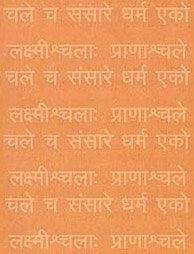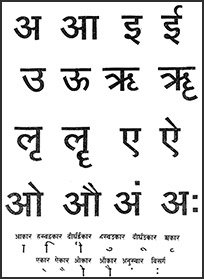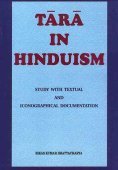Svatantra, Sva-tantra, Svatamtra: 22 definitions
Introduction:
Svatantra means something in Buddhism, Pali, Hinduism, Sanskrit, Jainism, Prakrit, the history of ancient India, Marathi. If you want to know the exact meaning, history, etymology or English translation of this term then check out the descriptions on this page. Add your comment or reference to a book if you want to contribute to this summary article.
In Hinduism
Samkhya (school of philosophy)
Source: Shodhganga: Prakrti and purusa in Samkhyakarika an analytical reviewSvatantra (स्वतन्त्र, “independent”).—Puruṣa is one of the two ultimate fundamental eternal realities according to Sāṃkhya. So, the puruṣa is not dependent on any cause for its existence. For this reason, puruṣa is svatantra (independent).

Samkhya (सांख्य, Sāṃkhya) is a dualistic school of Hindu philosophy (astika) and is closeley related to the Yoga school. Samkhya philosophy accepts three pramanas (‘proofs’) only as valid means of gaining knowledge. Another important concept is their theory of evolution, revolving around prakriti (matter) and purusha (consciousness).
Vyakarana (Sanskrit grammar)
Source: Wikisource: A dictionary of Sanskrit grammarSvatantra (स्वतन्त्र).—lit. independent; independent in activity; the subject or agent of an action (कर्ता (kartā)) is defined as स्वतन्त्र (svatantra) independent in his activity, i. e. not depending upon any one for the same; cf. स्वतन्त्रः कर्ता (svatantraḥ kartā) P. I. 4. 54.

Vyakarana (व्याकरण, vyākaraṇa) refers to Sanskrit grammar and represents one of the six additional sciences (vedanga) to be studied along with the Vedas. Vyakarana concerns itself with the rules of Sanskrit grammar and linguistic analysis in order to establish the correct context of words and sentences.
Purana and Itihasa (epic history)
Source: archive.org: Shiva Purana - English Translation1) Svatantra (स्वतन्त्र) refers to “independent [of attributes, saguṇa]”, and represents an epithet of Śiva, according to the Śivapurāṇa 2.2.10. Accordingly as Viṣṇu said to Brahmā:—“[...] He is distinct from illusion. He is free from desires. He is the creator of illusion yet uninfluenced by illusion. He is an adept. He is possessed of attributes (saguṇa) yet independent (svatantra) of them. He is blissful in Himself. He is free from suspicions and alternatives”.
2) Svatantra (स्वतन्त्र) refers to the “independent (great soul)”, according to the Śivapurāṇa 2.2.42.—Accordingly, as Dakṣa bowed and eulogised Śiva:—“[...] Today I have realised the truth. Thou art above all. Thou art served by Viṣṇu, Brahmā and others. Thou art the supreme Being known only through the Vedas. Thou art the wish-yielding Kalpa tree to the good. Thou punishest the wicked always. Thou art the independent great soul (i.e., svatantra—svataṃtraḥ paramātmā). Thou art the bestower of desired boons on the devotees. [...]”.

The Purana (पुराण, purāṇas) refers to Sanskrit literature preserving ancient India’s vast cultural history, including historical legends, religious ceremonies, various arts and sciences. The eighteen mahapuranas total over 400,000 shlokas (metrical couplets) and date to at least several centuries BCE.
Ayurveda (science of life)
Source: gurumukhi.ru: Ayurveda glossary of termsSvatantra (स्वतन्त्र):—Independent, autonomous. An attribute of Ātmā.

Āyurveda (आयुर्वेद, ayurveda) is a branch of Indian science dealing with medicine, herbalism, taxology, anatomy, surgery, alchemy and related topics. Traditional practice of Āyurveda in ancient India dates back to at least the first millenium BC. Literature is commonly written in Sanskrit using various poetic metres.
Shaktism (Shakta philosophy)
Source: Google Books: ManthanabhairavatantramSvatantra (स्वतन्त्र) means “freely”, according to the second recension of the Yogakhaṇḍa of the Manthānabhairavatantra, a vast sprawling work that belongs to a corpus of Tantric texts concerned with the worship of the goddess Kubjikā.—Accordingly, “[...] After the goddess Bhadrakālī heard this, that is, Śambhu's speech, the virgin (goddess) also came in the form of a divine virgin (kumārī) and freely uttered [i.e., svatantra] with all (her deepest) feelings (these) divine words. [....]”.
Source: Brill: Śaivism and the Tantric Traditions (shaktism)Svatantra (स्वतन्त्र) refers to “independent (scholars)”, according to the King Vatsarāja’s Pūjāstuti called the Kāmasiddhistuti (also Vāmakeśvarīstuti), guiding one through the worship of the Goddess Nityā.—Accordingly, “[...] The Vedas, independent scholars (viduṣa—viduṣaḥ svatantrāḥ) of different capabilities, the Tantras, the collection of mantras with celebrated powers, and thoughts and feelings concerning syntax and grammar and poetic compositions, all these, O mother, evolve to excellence from a millionth part of you”.

Shakta (शाक्त, śākta) or Shaktism (śāktism) represents a tradition of Hinduism where the Goddess (Devi) is revered and worshipped. Shakta literature includes a range of scriptures, including various Agamas and Tantras, although its roots may be traced back to the Vedas.
Jyotisha (astronomy and astrology)
Source: Wisdom Library: Brihat Samhita by VarahamihiraSvatantra (स्वतन्त्र) refers to “one who is a remarkable genius”, representing a desirable characteristic of an astrologer (Jyotiṣa), according to the Bṛhatsaṃhitā (chapter 2), an encyclopedic Sanskrit work written by Varāhamihira mainly focusing on the science of ancient Indian astronomy astronomy (Jyotiṣa).—Accordingly, “We shall now proceed to give a brief description of (the qualifications of) a jyotiṣaka. [...] He must be of cleanly habits, able, noble-minded, eloquent and of originality and imagination; must possess a knowledge of place and time; be meek and without nervousness, must be difficult of conquest by his fellow students; must be able and devoid of vices; must be learned in matters of expiatory ceremonies, of Hygiene, of Occult Magic and of ablutions; must be a worshipper of the Devas and an observer of fast and penance; must be of remarkable genius [i.e., svatantra] and capable of solving any difficulties save in matters of direct divine interference; and finally, he must be learned in astronomy, natural astrology (Saṃhitā) and horoscopy”.

Jyotisha (ज्योतिष, jyotiṣa or jyotish) refers to ‘astronomy’ or “Vedic astrology” and represents the fifth of the six Vedangas (additional sciences to be studied along with the Vedas). Jyotisha concerns itself with the study and prediction of the movements of celestial bodies, in order to calculate the auspicious time for rituals and ceremonies.
Shaivism (Shaiva philosophy)
Source: Google Books: Manthanabhairavatantram (shaivism)Svatantra (स्वतन्त्र) or Svatantratva refers to the “state of freedom”, according to the Mahānayaprakāśa by Arṇasiṃha (Cf. verse 182-197).—Accordingly, “He who, by virtue of the innate expansion (of his own consciousness) and freedom (svatantratva), assumes the nature of the senses, without (this thereby) diminishing the glorious power of the Inexplicable (Fourth State of consciousness) in the sphere the objects of sense and who, abandoning (all) exertion (for what is conventionally considered to be) right or wrong, moves (freely) at all times, is known as Meṣanātha who, endowed with the expansion (of consciousness), is ever intent (on realisation)”.
Source: SOAS University of London: Protective Rites in the Netra TantraSvatantra (स्वतन्त्र) refers to “Independence”, according to the Netratantra of Kṣemarāja: a Śaiva text from the 9th century in which Śiva (Bhairava) teaches Pārvatī topics such as metaphysics, cosmology, and soteriology.—Accordingly, [verse 21.6-9ab]—“But, if [mantras consist of] the forms of Śakti, whose Śakti and of what kind? O Deva, what [does] Śakti cause, what is her purpose, and of what kind is she? If [mantras] do not possess Śakti, what is worshipped with Śakti? Independence (svatantra) cannot be accomplished by anyone without perfection. [...]”.

Shaiva (शैव, śaiva) or Shaivism (śaivism) represents a tradition of Hinduism worshiping Shiva as the supreme being. Closely related to Shaktism, Shaiva literature includes a range of scriptures, including Tantras, while the root of this tradition may be traced back to the ancient Vedas.
In Buddhism
Mahayana (major branch of Buddhism)
Source: Wisdom Library: Maha Prajnaparamita SastraSvatantra (स्वतन्त्र) refers to “that which is autonomous”, according to Mahāprajñāpāramitāśāstra (chapter 31).—Accordingly, “Without knowing if the ātman exists or does not exist, you are asking why one does not produce the idea of the ātman in regard to another. [The distinctions] between one’s own body (ātmakāya) and another’s body (parakāya) exist as a function of the Ātman. But the Ātman is non-existent. [The characteristics attributed to it]: having form (rūpin) or formless (arūpin), permanent (nitya) or impermanent (anitya), finite (antavat) or infinite (ananta), moveable (gantṛ) or motionless (agantṛ), cognizant (jñātṛ) or ignorant (ajñātṛ), active (kāraka) or inactive (akāraka), autonomous (svatantra) or non-autonomous (asvatantra): all these characteristics of the ātman do not exist, as we have said above in the chapter on the Ātman. [...]”.

Mahayana (महायान, mahāyāna) is a major branch of Buddhism focusing on the path of a Bodhisattva (spiritual aspirants/ enlightened beings). Extant literature is vast and primarely composed in the Sanskrit language. There are many sūtras of which some of the earliest are the various Prajñāpāramitā sūtras.
In Jainism
General definition (in Jainism)
Source: The University of Sydney: A study of the Twelve ReflectionsSvatantra (स्वतन्त्र) refers to “independent”, according to the 11th century Jñānārṇava, a treatise on Jain Yoga in roughly 2200 Sanskrit verses composed by Śubhacandra.—Accordingly, “Why do the stupid, afflicted by the planet of [their] birth, not perceive the difference [between the body and the self] which is recognised everywhere in the occurrence of birth and death. Therefore, what is the connection of the self to that body which is made by atoms which are material, insentient, different [and] independent (svatantra)?”.

Jainism is an Indian religion of Dharma whose doctrine revolves around harmlessness (ahimsa) towards every living being. The two major branches (Digambara and Svetambara) of Jainism stimulate self-control (or, shramana, ‘self-reliance’) and spiritual development through a path of peace for the soul to progess to the ultimate goal.
India history and geography
Source: Cologne Digital Sanskrit Dictionaries: Indian Epigraphical GlossarySvatantra.—(SITI), a share; a customary fee; emoluments. Note: svatantra is defined in the “Indian epigraphical glossary” as it can be found on ancient inscriptions commonly written in Sanskrit, Prakrit or Dravidian languages.

The history of India traces the identification of countries, villages, towns and other regions of India, as well as mythology, zoology, royal dynasties, rulers, tribes, local festivities and traditions and regional languages. Ancient India enjoyed religious freedom and encourages the path of Dharma, a concept common to Buddhism, Hinduism, and Jainism.
Languages of India and abroad
Marathi-English dictionary
Source: DDSA: The Molesworth Marathi and English Dictionarysvatantra (स्वतंत्र).—a (S) Independent, uncontrolled, free, absolute; being under one's own line or law. Hence, by implication, Of age, full-grown. 2 (With reproachful implication.) Self-willed, unruly, refractory, libertine, dissolute &c. 3 (Laxly.) That is separate, apart, aside, aloof, out of the way.
Source: DDSA: The Aryabhusan school dictionary, Marathi-Englishsvatantra (स्वतंत्र).—a Independent, free. Self-willed.
Marathi is an Indo-European language having over 70 million native speakers people in (predominantly) Maharashtra India. Marathi, like many other Indo-Aryan languages, evolved from early forms of Prakrit, which itself is a subset of Sanskrit, one of the most ancient languages of the world.
Sanskrit dictionary
Source: DDSA: The practical Sanskrit-English dictionarySvatantra (स्वतन्त्र).—a.
1) self-dependent, uncontrolled, independent, self-willed.
2) of age, full-grown.
-ntram one's own (common group of) subsidiaries; जैमिनेः परतन्त्रापत्तेः स्वतन्त्रप्रतिषेधः स्यात् (jaimineḥ paratantrāpatteḥ svatantrapratiṣedhaḥ syāt) MS. 12.1.8.
-ntraḥ a blind man.
Svatantra is a Sanskrit compound consisting of the terms sva and tantra (तन्त्र).
Source: Cologne Digital Sanskrit Dictionaries: Shabda-Sagara Sanskrit-English DictionarySvatantra (स्वतन्त्र).—mfn.
(-ntraḥ-ntrā-ntraṃ) 1. Unrestrained, uncontrolled, self-willed. 2. Independent, free. 3. Full-grown, of age, no longer subject to the authority of parents, &c. E. sva own, tantra inclination, will.
Source: Cologne Digital Sanskrit Dictionaries: Benfey Sanskrit-English DictionarySvatantra (स्वतन्त्र).—[sva-tantra], see tantra.
Source: Cologne Digital Sanskrit Dictionaries: Cappeller Sanskrit-English DictionarySvatantra (स्वतन्त्र).—1. [neuter] self-dependence, i.e. independence, freedom; also tā [feminine]
--- OR ---
Svatantra (स्वतन्त्र).—2. [adjective] self-dependent, free.
Source: Cologne Digital Sanskrit Dictionaries: Monier-Williams Sanskrit-English Dictionary1) Svatantra (स्वतन्त्र):—[=sva-tantra] [from sva] a n. self-dependence, independence, self-will, freedom, [Pañcatantra; Hitopadeśa]
2) [v.s. ...] o°’s own system or school, [Suśruta]
3) [v.s. ...] o°’s own army, [ib.]
4) [v.s. ...] (with, [Buddhist literature]) a [particular] doctrine of free-will or independence, [Buddhist literature]
5) [v.s. ...] Name of [work] (also called tra-tantra)
6) [v.s. ...] mf(ā)n. self-dependent, self-willed, independent, free, uncontrolled (with pada n. ‘an ind° word’), [Lāṭyāyana; Upaniṣad; Manu-smṛti] etc.
7) [v.s. ...] mf(ā)n. of age, full grown, [Horace H. Wilson]
8) [v.s. ...] m. Name of a Cakra-vāka, [Harivaṃśa]
9) [=sva-tantra] b sva-tavas etc. See p. 1275, col. 3.
Source: Cologne Digital Sanskrit Dictionaries: Yates Sanskrit-English DictionarySvatantra (स्वतन्त्र):—[sva-tantra] (ntraḥ-ntrā-ntraṃ) a. Being one’s own master; of age; uncontrolled, independent, free.
[Sanskrit to German]
Sanskrit, also spelled संस्कृतम् (saṃskṛtam), is an ancient language of India commonly seen as the grandmother of the Indo-European language family (even English!). Closely allied with Prakrit and Pali, Sanskrit is more exhaustive in both grammar and terms and has the most extensive collection of literature in the world, greatly surpassing its sister-languages Greek and Latin.
Kannada-English dictionary
Source: Alar: Kannada-English corpusSvataṃtra (ಸ್ವತಂತ್ರ):—
1) [adjective] not under another’s or otherś control; able to act, think without compulsion, restraint, restriction, etc.; free.
2) [adjective] subject to, led by or indicative of caprice or whim; erratic; capricious.
--- OR ---
Svataṃtra (ಸ್ವತಂತ್ರ):—
1) [noun] a man who is not under another’s arbitrary control.
2) [noun] (gram.) a noun which is not relative or not depending on anotehr; an independent noun.
Kannada is a Dravidian language (as opposed to the Indo-European language family) mainly spoken in the southwestern region of India.
See also (Relevant definitions)
Partial matches: Shva, Tantra.
Starts with: Svatantra-patrakara, Svatantra-rupama, Svatantra-upanivesha, Svatantralekhana, Svatantramukhamardana, Svatantrapadopasthitipaksha, Svatantrasara, Svatantrata, Svatantrata-andolana, Svatantrata-divasa, Svatantrata-sangrama, Svatantrata-senani, Svatantratantra, Svatantratva, Svatantravicara, Svatantravritti, Svatantray, Svatantraya.
Ends with: Anvayasvatamtra, Asvatantra, Ekatamtrasvatamtra, Sarvasvatamtra, Sarvatamtrasvatamtra, Utpatasvatamtra.
Full-text (+53): Svatantrya, Svatantrata, Svatantrika, Atmatantra, Svatantratantra, Svatantralekhana, Svatantrasara, Svatantramukhamardana, Svatamtri, Svatantravritti, Asvatantra, Cukantiram, Agrihya, Cutantaran, Svatantrin, Cutantai, Asvatantrata, Sacantra, Vyavaharajna, Svatantari.
Relevant text
Search found 42 books and stories containing Svatantra, Sva-tantra, Svātantra, Svatamtra, Svataṃtra; (plurals include: Svatantras, tantras, Svātantras, Svatamtras, Svataṃtras). You can also click to the full overview containing English textual excerpts. Below are direct links for the most relevant articles:
Cidgaganacandrika (study) (by S. Mahalakshmi)
Verse 175 [Sṛṣṭikāli’s Dvādaśakrama Cidūrmi] < [Chapter 3 - Third Vimarśa]
Verse 188-189 [Reflection without an external object] < [Chapter 4 - Fourth Vimarśa]
Verse 219 [Kālana meaning and sense] < [Chapter 4 - Fourth Vimarśa]
Vasudevavijaya of Vasudeva (Study) (by Sajitha. A)
Kāraka (a): Kartṛkāraka < [Chapter 3 - Vāsudevavijaya—A Grammatical Study]
Kāraka in Grammar (Introduction) < [Chapter 3 - Vāsudevavijaya—A Grammatical Study]
The Agnistoma Somayaga in the Shukla Yajurveda (by Madan Haloi)
Somasaṃsthā (4): Ṣoḍaśī < [Chapter 3 - The Somayāga]
Part 2.6: The Paśuyāga Sacrifice < [Chapter 2 - An Introduction to the Ritualistic Religion of the Vedas]
Bhakti-rasamrta-sindhu (by Śrīla Rūpa Gosvāmī)
Verse 4.8.49 < [Part 8 - Compatible & Incompatible Mellows (maitrī-vaira-sthiti)]
Verse 2.4.216 < [Part 4 - Transient Ecstatic Disturbances (vyābhicāri-bhāva)]
Verse 2.4.218 < [Part 4 - Transient Ecstatic Disturbances (vyābhicāri-bhāva)]
The Tattvasangraha [with commentary] (by Ganganatha Jha)
Verse 3606-3610 < [Chapter 26 - Examination of the ‘Person of Super-normal Vision’]
Verse 3371-3373 < [Chapter 26 - Examination of the ‘Person of Super-normal Vision’]
Vakyapadiya of Bhartrihari (by K. A. Subramania Iyer)
Verse 3.7.95 < [Book 3 - Pada-kāṇḍa (7): Sādhana-samuddeśa (On the Means)]
Verse 3.3.6 < [Book 3 - Pada-kāṇḍa (3): Sambandha-samuddeśa (On Relation)]
Verse 3.7.122-123 < [Book 3 - Pada-kāṇḍa (7): Sādhana-samuddeśa (On the Means)]
Related products
